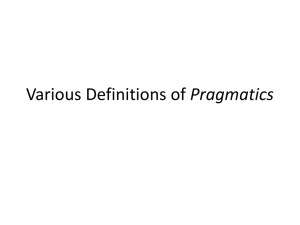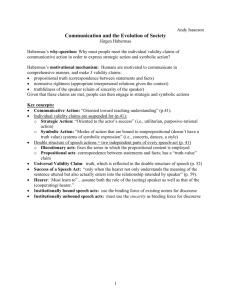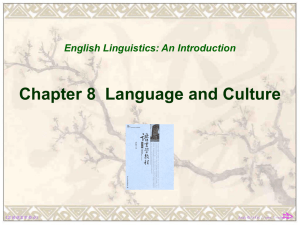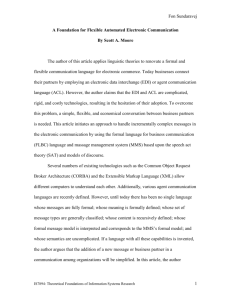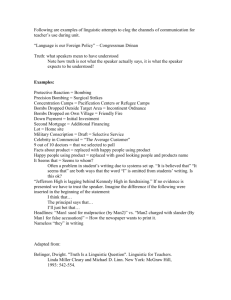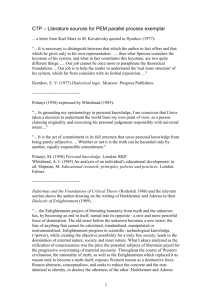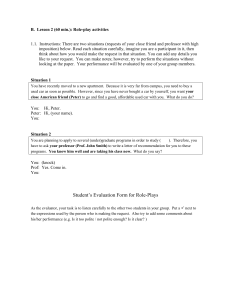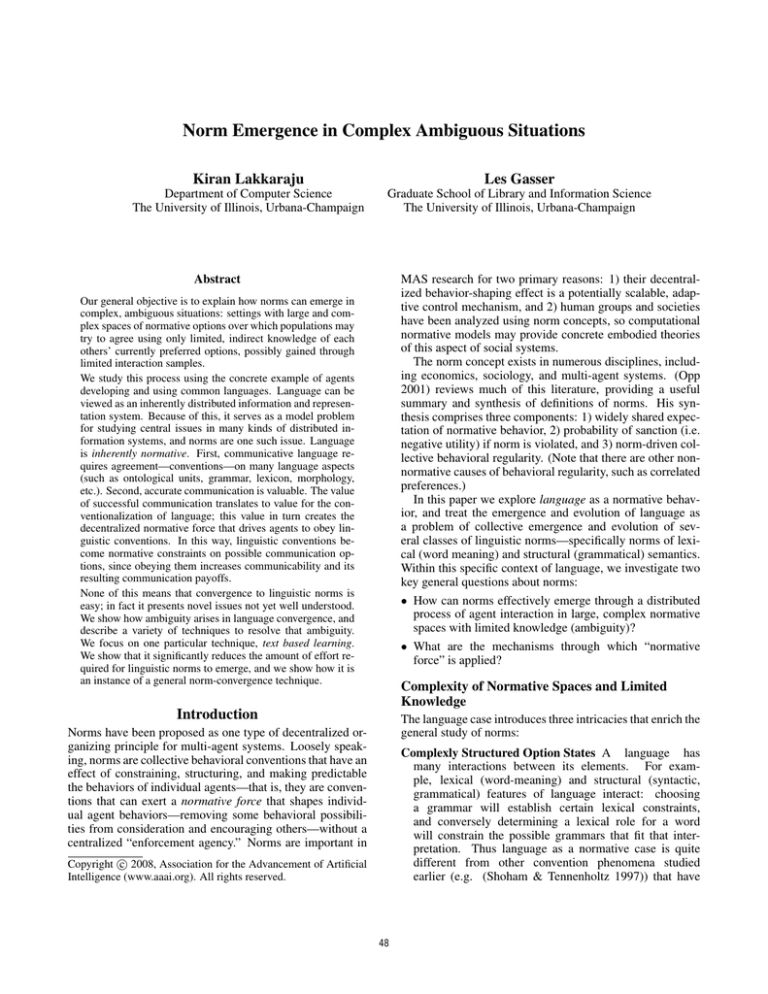
Norm Emergence in Complex Ambiguous Situations
Kiran Lakkaraju
Les Gasser
Department of Computer Science
The University of Illinois, Urbana-Champaign
Graduate School of Library and Information Science
The University of Illinois, Urbana-Champaign
MAS research for two primary reasons: 1) their decentralized behavior-shaping effect is a potentially scalable, adaptive control mechanism, and 2) human groups and societies
have been analyzed using norm concepts, so computational
normative models may provide concrete embodied theories
of this aspect of social systems.
The norm concept exists in numerous disciplines, including economics, sociology, and multi-agent systems. (Opp
2001) reviews much of this literature, providing a useful
summary and synthesis of definitions of norms. His synthesis comprises three components: 1) widely shared expectation of normative behavior, 2) probability of sanction (i.e.
negative utility) if norm is violated, and 3) norm-driven collective behavioral regularity. (Note that there are other nonnormative causes of behavioral regularity, such as correlated
preferences.)
In this paper we explore language as a normative behavior, and treat the emergence and evolution of language as
a problem of collective emergence and evolution of several classes of linguistic norms—specifically norms of lexical (word meaning) and structural (grammatical) semantics.
Within this specific context of language, we investigate two
key general questions about norms:
• How can norms effectively emerge through a distributed
process of agent interaction in large, complex normative
spaces with limited knowledge (ambiguity)?
• What are the mechanisms through which “normative
force” is applied?
Abstract
Our general objective is to explain how norms can emerge in
complex, ambiguous situations: settings with large and complex spaces of normative options over which populations may
try to agree using only limited, indirect knowledge of each
others’ currently preferred options, possibly gained through
limited interaction samples.
We study this process using the concrete example of agents
developing and using common languages. Language can be
viewed as an inherently distributed information and representation system. Because of this, it serves as a model problem
for studying central issues in many kinds of distributed information systems, and norms are one such issue. Language
is inherently normative. First, communicative language requires agreement—conventions—on many language aspects
(such as ontological units, grammar, lexicon, morphology,
etc.). Second, accurate communication is valuable. The value
of successful communication translates to value for the conventionalization of language; this value in turn creates the
decentralized normative force that drives agents to obey linguistic conventions. In this way, linguistic conventions become normative constraints on possible communication options, since obeying them increases communicability and its
resulting communication payoffs.
None of this means that convergence to linguistic norms is
easy; in fact it presents novel issues not yet well understood.
We show how ambiguity arises in language convergence, and
describe a variety of techniques to resolve that ambiguity.
We focus on one particular technique, text based learning.
We show that it significantly reduces the amount of effort required for linguistic norms to emerge, and we show how it is
an instance of a general norm-convergence technique.
Complexity of Normative Spaces and Limited
Knowledge
Introduction
The language case introduces three intricacies that enrich the
general study of norms:
Norms have been proposed as one type of decentralized organizing principle for multi-agent systems. Loosely speaking, norms are collective behavioral conventions that have an
effect of constraining, structuring, and making predictable
the behaviors of individual agents—that is, they are conventions that can exert a normative force that shapes individual agent behaviors—removing some behavioral possibilities from consideration and encouraging others—without a
centralized “enforcement agency.” Norms are important in
Complexly Structured Option States A language has
many interactions between its elements. For example, lexical (word-meaning) and structural (syntactic,
grammatical) features of language interact: choosing
a grammar will establish certain lexical constraints,
and conversely determining a lexical role for a word
will constrain the possible grammars that fit that interpretation. Thus language as a normative case is quite
different from other convention phenomena studied
earlier (e.g. (Shoham & Tennenholtz 1997)) that have
c 2008, Association for the Advancement of Artificial
Copyright Intelligence (www.aaai.org). All rights reserved.
48
a simple binary normative option space. Here we need
to treat lexicon and grammar as complex interdependent
norm components, and to find ways of making their joint
emergence tractable for agents - our approach to this is
one of the central insights of the paper.
Learning curve --- Iterations vs. Communicabilty (mean of 10 runs)
1
0.8
Avg. Communicability
Large Normative Option Space Certain aspects of a language’s lexicon can change independently from its grammar - for example, words in an established grammatical category (“noun,” “verb”) can be added to or deleted
from the language without changing its grammar. Thus
the space of possible options for interpreting an utterance changes multiplicatively with changes to the lexical and/or grammatical complexity. For this reason,
there is an enormous number of possible combined lexical/grammatical interpretations for a given utterance
when the language is even moderately complex. A population must converge on a shared lexical and grammatical
convention within this very large space—again, a significant difference from earlier studies with binary normative
spaces.
0.6
0.4
0.2
0
0
2000
4000
6000
8000
10000
12000
14000
16000
18000
20000
Number of iterations
Correct Strategy
Weighted All lex
Weighted Text
Figure 1: Convergence curve for 20 agents and 30 meanings.
There are 27 object predicates and 3 event predicates.
Ambiguity and Imperfect Knowledge Agents have no direct access to others’ preferred linguistic choices (normative states). Instead they must infer other agents states on
the basis of limited linguistic samples (utterances) possibly coupled with a limited number of shared situations
from which to “ground” semantic choices. In general,
this limits agents to imperfect knowledge of collectivelypreferred normative options, creating ambiguity when
they try to converge. Again, this differs significantly from
binary option spaces in which knowledge of other agents’
states can be inferred perfectly: ¬1 = 0 and ¬0 = 1.
they encourage communicability and thus higher task payoffs. Violation of linguistic norms leads to lower payoffs,
which can be interpreted as sanctions. When agents act outside the linguistic norm, their lower communicability yields
lower payoffs, i.e. sanctions.
A major aspect of norm research is focused on the internalization of norms, which naturally flows from our modelization of conventions and normative force—our work
follows in the vein of (Shoham & Tennenholtz 1997;
Savarimuthu et al. 2007). Reification or immergence of
norms to provide second-order behavioral control is not
treated here; for an account of it see, e.g., (Andrighetto et
al. 2007).
Normative Force in Language
In Opp’s conceptualization of norms (Opp 2001) the issue
of normative force is covered by reference to “probability
of sanctions.” A norm carries some probability of sanction (negative utility) when violated. Our model of how
normative force appears in the context of language use is
based on the notion of communicability, or mutual intelligibility between agents. We assume that the ability to communicate via language confers an advantage or payoff to
agents. For example, linguistic competence may give agents
access to otherwise-inaccessible knowledge, or it may allow agents to coordinate more effectively. Both of these
may improve performance on (increase payoff from) collective tasks. The communicability of two agents, speaker and
hearer, can be quantified as the fraction of all possible situations that the speaker can accurately communicate to the
hearer (see below). Average population-wide communicability is increased by converging more closely to a common
language, so that when two random agents interact over a
random situation, their expected task payoff is higher. Since
reliable communication has value, and we assume agents
want to increase their payoffs from tasks, communicability
provides the decentralized normative force encouraging the
behavior of more closely conforming to widely-shared languages. Widely held linguistic conventions become normative constraints on possible communication options because
The Ambiguity Problem
One of the aspects of the complex setting of language is ambiguity due to imperfect knowledge. Ambiguity arises in
situations where agents utilize imperfect knowledge of another agents behaviors. When agents are faced with imperfect knowledge the ability for a norm to develop will be affected.
The effect of ambiguity is clearly present in the case
of language convergence. In cases where a population of
agents must form a linguistic norm imperfect knowledge
causes a significant increase in the time to form a common
language.
Figure 1 shows the time to convergence for a population
of agents. The x axis indicates time (measured in number
of interactions) and the y access indicates the average communicability of the population. When the population has
reached an average communicability of 1 a linguistic norm
has been achieved.
The left hand curve is the situation where agents are given
perfect knowledge of another agents linguistic behaviors. A
linguistic norm is achieved in around 6000 iterations. This is
the optimal case, where we as the designers, have provided
49
the agents with the correct information.
The curve on the right is the situation with imperfect
knowledge. We can see that in the case of imperfect knowledge there is a significant increase in the amount of time to
convergence. A norm is only achieved in 12,000 iterations.
The increase is because of the errors agents make due to ambiguity as to the correct linguistic behavior of other agents.
Our objective is to identify and develop techniques to address the ambiguity problem and bridge the gap between the
perfect case and the imperfect knowledge case.
The rest of the paper is organized as follows. In the
“Settings” section we describe the setting in which we explore language convergence and ambiguity. The “Imperfect
Knowledge Leads to Ambiguity” section illustrates how ambiguity arises in the language case, and general methods for
resolving such ambiguity. The “Text-Based Ambiguity Reduction Strategies” section and the “Text Based Observation Games” section go over one technique, the “Text Based
Observation Game” that we have developed. The “Results”
section evaluates how well the text based observation game
reduces ambiguity.
Logic (FOL) based representation. For instance, the scene
“Dog chases cat” is encoded:
Dog(x) ∧ Cat(y) ∧ Chase(z) ∧ Agent(x) ∧ Patient(y)
∧Event(z) ∧ TransitiveAction(z, x, y)
This scene contains three entities: a dog (Dog(x)), a cat
(Cat(y)) and the “chasing” event (Chase(z)).
Variables represent entities in the environment. Single arity predicates represent properties of the entity, i.e., Red(x)
means the entity x refers to has the property of being red.
Chase(y) means that the entity referred to by y has the property of being a chase event.
Multi-arity predicates refer to relations between entities
in the world. We only utilize one relation: TransitiveAction(x, y, z). This predicate indicates that entity y is performing the action referred to by x upon z.
Clearly the ordering of TransitiveAction’s arguments is
key. We introduce the notion of Semantic roles; properties
of entities that reflect their status in the relation. There are
three semantic roles: Agent(·) (the property of being the entity doing the action), Patient(·) (the property of being the
entity upon whom the action is being done), and Event(·)
(the property of being the action entity). Agent(x) means
that the entity referred to by x has the semantic role of an
Agent, and similarly for the other semantic roles. The TransitiveAction predicates ordering is that of Event, Agent then
Patient.
The predicates Agent(x), Patient(y) and Event(z) in the
example above indicate that the dog is the agent (and thus
chasing), while the cat is the patient and is being chased.
Event(z) indicates that Chase(z) is the action entity.
Agents utilize a set of linguistic behaviors – a language
– in order to communicate with each other. Their language
transforms their internal representations – meanings – into
an external form, comprised of words organized into sentences. Languages are bidirectional, encoding meanings as
forms and decoding forms to meanings. In this work we
assume all agents accurately perceive and utilize the same
FOL internal representation.
Setting
Agents
The simulation setting contains a population of agents, denoted A.
The agents are taking part in a Description Task: their objective is to describe scenes from the environment to each
other. Describing the relation between two or more objects
is a crucial prerequisite to more complex interactions concerning coordination, cooperation and negotiation.
The agents can perceive and represent scenes from the environment (to be described below) internally. Agents also
have a set of linguistic behaviors that they use to transform
their internal representation of scenes into communicable
forms.
Agents are endowed with a memory that keeps track of
scenes they have seen. No memory capabilities beyond this
are assumed.
The Environment
Our environment contains two types of entities:
Linguistic Behaviors
Objects Objects are physical entities in the world, such as
cats, dogs, trees, etc.
Actions Actions are activities/events that occur with respect
to objects in the world. There can be no action without
one or more objects, e.g. the action of chasing requires an
object as a chaser and an object to be chased.
Linguistic behaviors specify how to encode and decode. Each linguistic behavior specifies a different encoding/decoding for some meaning/form. Agents will have
conflicting linguistic behaviors that provide different encodings/decodings for the same meaning/form. The goal is for
the population of agents to constrain their set of linguistic
behaviors such that they can effectively communicate. The
metric to evaluate successful communication is described in
the “Evaluation Metrics” section.
In this work we will focus on compositional languages.
A compositional language has structured forms where the
meaning is a function of the meanings of the parts and the
way they are combined (Johansson 2006; Krifka 1999).
Consider the meanings of the two sentences below:
A scene drawn from the environment is a relationship
between two objects and an action. For example, a scene
would be a dog chasing a cat.
The environment is strategically simple in order to focus
on the ambiguity problem. We find that even with such a
simple environment substantial ambiguity will arise.
All agents can accurately perceive the environment and
represent scenes in the environment using a First Order
50
finding the meaning for a word the meaning with the highest
weight is chosen. When producing a word for a meaning,
the highest weighted meaning is chosen.
The grammar is implemented as an association matrix as
well. When parsing or producing a sentence the grammar
with the highest weight is chosen. To simplify notation we
only indicate the winning word-meaning pairs and highest
valued grammars in the figures.
The dog chases the cat.
The cat chases the dog.
Both sentences have the same constituent parts, however
the ordering of the parts affects their meaning. Since English
follows a Subject-Verb-Object ordering, the first element has
the semantic role of “agent” and the third element that role
of “Patient”
Notice that there is no word in the lexicon that specifies
the semantic role of “dog”. This meaning is specified in the
structure of the sentence.
To implement a compositional language, agents will have
to specify how meanings are encoded as words, and secondly how words are combined into sentences and how the
structure of the sentence encodes meaning. These components of a language are called the lexicon and the grammar
respectively.
We provide agents with a strategically simplified set of
linguistic behaviors in which sentences will be limited to 3
words. As we already mentioned, all agents are utilizing
the same internal representation of scenes. The environment
will have a fixed, and known to all, set of entities.
Here is a simple language as an illustration:
•
•
•
•
•
•
•
•
Language Games
A language game is a way for an agent to gain knowledge of
another agents linguistic behavior. The language game, and
the associated update rule, define the behavior of the agent
in the system.
Language games were initially developed by Steels in
(Steels 1996). A (pair-wise) language game is an interaction
between two agents, one of which is designated the speaker
and the other the hearer. There are two main variants of the
game, which we call the observation game and the guessing
game following (Vogt & Coumans 2003). We will focus on
the observation game.
In the observation game two agents establish joint attention on some part of the environment. This could be an object, or a complex scene describing several objects together.
Regardless, the portion of the environment which is agreed
upon will be called the topic.
The speaker agent produces a sentence that represents the
topic. This sentence is passed to the hearer. The hearer determines if their language would produce the same sentence
for the same meaning. If the hearer’s language would do so,
the game is successful. If not, the game is a failure.
In cases of failure, the speaker and hearer decrease the
associations between the sentence and topic that they were
using. In the case of success, the association between the
sentence and the topic is increased, and competing associations are decreased (Vogt & Coumans 2003). The underlying principle of the update rules is for agents to change their
language so that they are closer to each others language.
Lexicon:
w1 ↔ Dog(·)
w2 ↔ Cat(·)
w3 ↔ Chase(·)
w4 ↔ Car(·)
w5 ↔ Ball(·)
w6 ↔ Jumps(·)
Grammar: Agent-Patient-Event
Figure 2: Sample Speakers Language
The lexicon in Figure 2 specifies how words are linked to
meanings. There are only 6 words, w1 . . . w6 . w1 is mapped
to the entity Dog(·), which means that w1 refers to some
entity (the argument) that has the property of being a Dog.
The ordering of elements in the grammar indicates the semantic roles of the referred entities. In this example, the entity referred to by the first word will be labeled Agent(·), the
second entity will be labeled Patient(·), and the third entity
will be labeled Event(·). Together, the lexicon and grammar
provide a way of encoding (producing) and decoding (parsing).
Take the sentence w2 w5 w3 . First, each individual word
is parsed and the meanings identified using the lexicon:
Cat(x) ∧ Ball(y) ∧ Chase(z). Then, taking the order of the
words into account, we can identify the semantic roles of
each entity, and then the relationship between all the entities.
To parse a sentence the process goes backwards. First the
words for each entity in the scene are found based on the
lexicon; then based on the semantic role of each entity in the
scene the words are placed in the appropriate order.
Following (Vogt & Coumans 2003; Steels 1996) we implement the lexicon as an association matrix. For every
word-meaning pair there is an association weight. When
Evaluation Metrics
The emergence of a linguistic norm will allow agents to effectively communicate. We test the extent to which the norm
is shared in the population by measuring the communicability of the population.
The communicability of two agents, one being the speaker
and one the hearer, is the fraction of all possible scenes in the
environment that the speaker can accurately communicate to
the hearer. For each scene the encoding of the speaker is decoded by the hearer; if the hearers decoded meaning matches
the speakers meaning communication was successful. The
communicability over a population is the average communicability over all pairs of agents as speaker and hearer. Communicability will be a value between 0 and 1.
When the communicability of a population is 1, every pair
of agents can accurately communicate all scenes. A linguistic norm has been achieved – all agents have constrained
their linguistic behavior. An agent that violates this linguistic norm is sanctioned in the sense that it cannot accurately
communicate.
51
With respect to norm emergence, we are interested in the
time to emergence, which we measure in terms of the number of interactions before a norm emerges.
can be likened to ambient language. While texts carry no semantics (they are just ungrounded strings that need to be interpreted) the hearer can compare them with its world model
to identify object-word correlations and word-position patterns, gaining ambiguity-reducing knowledge.
Texts have the advantage that they can be produced without the expensive co-presence and coordination of pointing and specific reference required for standard observation
games. This is somewhat balanced, however, by the lack
of semantic knowledge with which to ground the syntax
present in the text.
We call our text-enhanced version of the standard observation game the Text-Based Observation Game (TOG). In
the TOG, for each scene and interaction, the hearer receives
a descriptive utterance and also has access to a text generated by the speaker. The hearer keeps track of the scenes it
has encountered.
We assume three things, (1) that generated texts are about
the environment; (2) the environment is stationary; and (3)
all agents are using the same type of language (i.e. same positional type of grammar, with possibly different positionrole assignments). Given these assumptions, an agent can
statistically match the frequency of elements in the text to
elements in the environment and gain an approximate understanding of the meanings of some of the words. We argue
that this information is enough to resolve, to a large extent,
the ambiguity problem.
An example illustrates the proposed technique. Suppose
we have the speaker’s language that is defined in Figure 2.
We can generate a text for the speaker by having the speaker
encode randomly drawn scenes from the world. One possible text is shown on the left hand side below:
Imperfect Knowledge Leads to Ambiguity
The observation game defined in the “Language Games”
section allows agents to gain knowledge of other agents linguistic behaviors. However, the knowledge gained through
the game is imperfect. The imperfect knowledge leads to
ambiguity on the hearers part of what the linguistic behaviors of the speaker are. We call this the ambiguity problem
Figure 3 illustrates the ambiguity problem. In it a shared
scene, at the top, is described by the speaker. The speaker
produces the utterance “gavagai mischal wooziar”. The
hearer has many possible interpretations of how the speaker
produced the sentence that differ on what each word means.
The observation game only provides knowledge of the
speakers sentence. Each word of the speakers sentence can
refer to any of the three possible entities in the scene. All
6 possible interpretations are correct, in the sense that the
speaker could be utilizing such a linguistic behavior. The
hearer agent simply cannot determine the correct interpretation from the knowledge in the observation game.
As we saw above, the update rule for the hearer depends
upon accurate knowledge of the speakers linguistic behavior.
If the hearer does not choose the correct interpretation, then
its update will lead to a decrease in communicability.
The interaction between the lexical component and the
grammatical component in a hearer’s language causes ambiguity in interpretation of the speaker’s sentence. The hearer
does not unambiguously know what the speaker’s language
is.
1 w1 w2 w3
f f1 f2 f3
2 w1 w4 w3
w1 4 3 1 0
3 w5 w2 w6
w2 4 2 2 0
4 w5 w4 w6
w3 4 0 0 4
5 w2 w4 w6
w4 3 0 3 0
6 w2 w5 w3
w5 5 3 2 0
7 w5 w1 w6
w6 3 0 0 3
8 w1 w5 w3
Since the agents use a positional grammar in which
a words position in a sentence impacts its interpretation,
the frequencies of the words in various positions provides
knowledge about the words’ functions in the sentence. From
the text, we can calculate the frequencies of words and their
position in the sentence. This frequency table is shown next
to the text. The first column is the total frequency of the
word in the text, and column fi indicates the frequency of
the word in position i of the sentence.
The frequency table provides insight into the syntax of the
language. Namely, note that some words (such as w1 and
w2 ) only appear in positions 1 and 2 throughout the text.
On the other hand, some words (such as w3 ) only appear in
position 3 throughout the text.
The words in the text reflect patterns in the world. According to the speaker’s language in Figure 2 w3 refers to
the predicate Chase(·). Every scene that contains this predicate identifies it as having the event semantic role. Thus, the
Strategies for Reducing Ambiguity
Techniques for reducing ambiguity revolve around two
methods:
1. Constrain the complexity of the behaviors so that perfect
knowledge can be achieved;
2. Provide extra knowledge to aid in discriminating the correct interpretation.
The first approach can be implemented as a “developmental trajectory”. Initially the complexity of the linguistic behaviors would be constrained, i.e. agents will utilize languages with a fixed grammar. Once a high level of
communicability has been reached, the constraint is lifted.
(Lakkaraju, Gasser, & Swarup 2008) focuses on a developmental trajectory approach to language convergence.
The second option requires extra knowledge to be obtained from some method. We focus on this approach in
this paper.
Text-Based Ambiguity Reduction Strategies
Our method for adding extra information is for agents to infer structural information through the use of texts that provide purely syntactic information about a language. Texts
52
Unknown to Hearer
Speaker
Cognition
Hearer
Cognition
Speaker Language
Chase(z) gavagai
Cat(y) mischal
Speaker
Interpretation
Dog(x)
Dog(x) ∧ Cat(y) ∧ Chase(z) ∧
Agent(x) ∧ Patient(y) ∧ Event(z)
wooziar
Speaker Sentence
Grammar
EVENT-P
T PATIENT
T-AGENT
EVENT-PATIENT-AGENT
Hearer
Interpretation
gavagai mischal wooziar
Hearers
Possible Interpretations of
Speakers Language
Dog(x1) ∧ Cat(y1) ∧ Chase(z1) ∧
Agent(x1) ∧ Patient(y1) ∧ Event(z1)
Possible Interpretations
Interpretation 1
gavagai
mischal
wooziar
Dog(x1)
Cat(y1)
Chase(z1)
Grammar
AGENT-PATIENT-EVENT
Interpretation 2
Interpretation 3
Interpretation 4
gavagai
Cat(y1)
mischal
Dog(x1)
wooziar Chase(z1)
Grammar
PATIENT-AGENT-EVENT
gavagai
Cat(y1)
mischal Chase(z1)
Dog(x1)
wooziar
Grammar
gavagai
mischal
wooziar
Interpretation 5
Dog(x1)
Chase(z1)
Cat(y1)
gavagai
mischal
wooziar
Grammar
AGENT-EVENT-PATIENT
PATIENT-EVENT-AGENT
Chase(z1)
Dog(x1)
Cat(y1)
Grammar
EVENT-AGENT-PATIENT
Interpretation 6
gavagai Chase(z1)
mischal Cat(y1)
wooziar
Dog(x1)
Grammar
EVENT-PATIENT-AGENT
Figure 3: On the left is the shared scene that is viewed by both the hearer and speaker. The speakers language encodes the scene
as “gavagai mischal wooziar”. The hearer can interpret the sentence with reference to the shared scene in 6 different ways, or
strategies. Only one of the interpretations matches the speakers language (shown in the shaded area). Each interpretation is a
hypothesis about the speakers language based on the knowledge gained in the observation game. For example, Interpretation
1 hypothesizes that the speakers language encodes Dog(·) as gavagai, Cat(·) as mischal and Chase(·) as wooziar; and that the
speakers grammar is of the form Agent-Patient-Event
Using the texts agents develop Language Hypothesis – informed guesses about the structure of a language. In the text
based observation game, the hearer constructs a language
hypothesis through the evaluation of distributional similarity between words in the speakers text and its scene store.
The language hypothesis will be used to weigh the hearers
strategies.
speaker’s language assigns the word to the third position in
every sentence.
In addition, there are distributional patterns that can be
elicited from the text. In addition to the text generated from
the speaker, the hearer has a scene store that contains scenes
that the hearer has witnessed. Similar to the statistics generated for a text, we can generate the frequency with which
predicates appear with certain semantic roles.
Suppose the hearer agent has seen two scenes, where the
frequency table is:
f
Dog(?)
2
Cat(?)
2
Chase(?) 2
fAgent
2
1
0
fP atient
0
1
0
Text Based Observation Games
The Text based observation game allows hearer agents to utilize texts to generate language hypotheses about the speakers
language.
The hearer creates a set of strategies that define the possible structures of the speakers language. For every language
game there are 6 possible strategies that the hearer has to
choose from. Each strategy proposes a different updating of
the speaker and hearer agents lexicon and grammar weightings.
Only one of the strategies matches the language of the
speaker, this is called the correct strategy.
The hearer uses four metrics to evaluate and weight the
strategies:
fEvent
0
0
2
This table indicates the frequencies of predicates from the
scene store. The first column indicates the frequency of the
predicate in the scenes, and the rest indicate the frequency of
the predicate in a particular semantic role (i.e., as a patient,
or event etc.)
Comparing the two frequency tables we can notice that
some of the words match in distribution over positions with
the distribution of the predicates over semantic roles. This
correlation between the distribution of the word over position and the distribution of a predicate over roles provides
evidence that word w3 should be linked to the Chase predicate. With this information, we can weight the interpretations of the speaker’s sentence and then choose the interpretation that matches the text the best.
The correlations offered by the texts do not fully specify
the language of the speaker. However, they provide enough
evidence, under the assumptions made above, to reduce the
ambiguity in the interpretation of the outcome of a language
game.
Lexical Metric: xl Percentage of the word meaning pairs
in the strategy that correspond to word meaning pairs in
the hearers language.
Grammatical Metric: xg Set to 1 if the grammar in the
strategy is the same as the hearers current grammar.
Text Lexical Metric: xtl Percentage of word meaning
pairs in the strategy that are in the language hypothesis
derived from the text.
Text Grammatical Metric: xtg The weight of the strategies grammar in the language hypothesis derived from the
text.
53
The hearer assigns a weight to each strategy based on the
weighted sum of all four metrics:
Learning curve --- Iterations vs. Communicabilty (mean of 10 runs)
1
wl xl + wg xg + wtl xtl + wtg xtg
where, wl + wg + wtl + wtg = 1.
wl ,wg ,wtl ,wtg reflect the preferences of the hearer on how
to change its language. For instance, a weighting of wl =
1.0, wg = 0.0, wtl = 0.0, wtg = 0.0 means that the hearer
agent prefers strategies that match its current lexicon, which
means that they will produce the least amount of change to
its lexicon. The strategy with the highest correspondence to
the hearers language will be chosen in that case.
The exact method by which the agent updates its weights
is given below. the highest weighted strategy is denoted by
The correct strategy is denoted by θ∗ . We can also conθ.
struct a “strategy” that reflects the way the hearer decoded
the sentence, this is denoted as θ̃.
An agent updates its association matrix according to:
Avg. Communicability
0.8
0.6
0.4
0.2
0
0
2000
4000
6000
8000
10000
12000
14000
16000
18000
20000
Number of iterations
Correct Strategy
Weighted All lex
Weighted Text
Figure 4: Convergence curve for 20 agents and 30 meanings.
Comprehensible & Success Method:
• Speaker increases θ∗
• Hearer increases θ
For the experiments here, the parameters were: na = 20,
no = 27, ne = 3, nt = 100, and nm = 20
The experiments were:
Comprehensible & Failure Method:
• Speaker decreases θ∗
• Hearer decreases θ
Correct Strategy The perfect knowledge situation. The
hearer agent was given the correct interpretation.
• Hearer decreases θ̃
Incomprehensible & Failure Method:
its language.
• Hearer adds unknown words from θto
All Lex In this experiment we measured how fast agents
could converge when they relied only on xl . Correspondingly, we set wl = 1.0 and everything else to 0.0. This is
the imperfect knowledge case.
Incomprehensible & Success Can never happen!
Results
Weighted Text In this experiment we measured how fast
agents could converge when they relied on a text. The
agents used a text, and the weights were set to: wl =
.5, wtl = 0.5 and all other weights set to 0.0.
Our experiments indicate that Text based learning provides
substantial extra information to allow for a significant reduction in ambiguity. This lead to a 40% decrease in the amount
of time to converge as compared to a method that does not
use texts.
This performance increase was due to a decrease in the
number of mistakes on the hearer’s part when choosing a
strategy. The text based strategy had nearly half the errors
of the non text based strategy.
We performed 3 different experiments. Each experiment
used an environment with 30 entities and a population of 20
agents. Three of the 30 entities were events, and the other
27 were objects. There were 27 ∗ 26 ∗ 3 = 2106 possible
scenes described in the world. The number of words was not
bounded, but agents could only construct 3 word sentences.
The three semantic roles were fixed for all agents. In all
experiments all the agents started out with random grammars and empty lexicons.
There are 5 important parameters. na is the number of
agents in a population, no is the number of object meanings,
ne is the number of event meanings, nt is the size of the text,
nm is the size of the scene store for each agent.
Figure 4 shows the convergence curves (averaged over 10
runs) for these different experiments.
In an optimal setting there would be no ambiguity for the
hearer agent in determining the language of the speaker —
thus leading to quick convergence. We tested this hypothesis
by simulating a situation where the hearer agent always has
access to the correct strategy. Figure 4 shows the convergence curve for the three experiments. A convergence curve
plots the average communicability over all pairs of agents in
the population over time. Communicability can range from
0, where none of the agents speak the same language, to 1,
where all the agents speak the same language.
The solid line in Figure 4 is the convergence curve for the
correct strategy experiment. It is clear that when the correct
strategy was given to the hearer agent, the population converged quickly to a common language. The quick increase
in communicability corresponded to the point when all the
agents in the population converged on the same grammar.
On the other hand, the dashed line (far right in Figure 4)
shows the convergence curve for the All Lex experiment.
We can see that in this case there is a substantial increase in
the number of interactions for agents to converge on a single
• Speaker decreases θ∗
• Hearer decreases θ
54
We showed how ambiguity due to imperfect knowledge
affects the amount of time it takes for a norm to emerge.
We outlined two solutions to this problem and provided a
detailed solution in the form of Text Observation Games.
Through the use of collections of sentences generated at random from the speakers language – a text – we show how to
handle the ambiguity that arises. Through the use of texts,
there is a significant decrease in the time to establish a linguistic norm, as well as a significant decrease in the number
of errors.
Numerous further extensions to this work are possible.
The current interaction topology allows all agents to interact with all other agents, which is clearly unrealistic. We
intend to explore and compare our methods on scale-free,
small world and other networks; (Savarimuthu et al. 2007)
has shown norm emergence with similar topologies. Currently texts are generated per interaction, making them accurate reflections of the speakers language. A more realistic approach would have texts generated only periodically
while. We plan on investigating how the time between text
generation can influence norm emergence.
Error Curve
8000
Weighted Text
Weighted All Lex
Correct Strategy
Average Cummulative Number of Errors
7000
6000
5000
4000
3000
2000
1000
0
0
1000
2000
3000
4000
5000
6000
7000
8000
Failures
Figure 5: We see a steady increase in failures, then no failures occurring. The number of failures is longer for the all
text case and the text case as compared to the correct strategy
case.
References
Andrighetto, G.; Campennı́, M.; Conte, R.; and Paolucci,
M. 2007. On the immergence of norms: a normative
agent architecture. In Proceedings of AAAI Symposium,
Social and Organizational Aspects of Intelligence, Washington DC.
Johansson, S. 2006. Working backwards from modern language to proto-grammar. In Proceedings of the 6th International Conference on the Evolution of Language, 160–167.
Krifka, M. 1999. Compositionality. In MIT Encyclopedia
of Cognitive Science. MIT Press.
Lakkaraju, K.; Gasser, L.; and Swarup, S. 2008. Language
scaffolding as a condition for growth in linguistic complexity. In In Proceedings of EvoLang 2008.
Opp, K.-D. 2001. How do norms emerge? an outline of a
theory. Mind and Society 3:101–128.
Savarimuthu, B. R.; Cranefield, S.; Purvis, M.; and Purvis,
M. 2007. Role model based mechanism for norm emergence in artificial agent societies. In Proceedings of
the Workshop on Coordination, Organizations, Institutions
and Norms at AAMAS 2007.
Shoham, Y., and Tennenholtz, M. 1997. On the emergence
of social conventions: modeling, analysis, and simulations.
Artificial Intelligence 94(1-2):139–166.
Steels, L. 1996. Emergent adaptive lexicons. In Proceedings of the Fourth International Conference on Simulating
Adaptive Behavior.
Vogt, P., and Coumans, H. 2003. Investigating social interaction strategies for bootstrapping lexicon development.
Journal of Artificial Societies and Social Simulation 6.
language. The population does converge, yet it takes a much
longer time to do so.
The dotted line between the correct strategy convergence
curve and the all lex convergence curve is the convergence
curve for the text experiment. While the population does not
converge as quickly as in the correct strategy case, the population does converge faster than in the All Lex experiment.
As we noted above, the decrease in the amount of time
to convergence is due to the lessening of ambiguity in
the hearer agent. The text provides information about the
speaker’s language that allows the hearer to make a better
choice of strategy. The increase in knowledge gained by
texts translates into a decrease in the number of wrong strategies chosen by the hearer agent.
The error rate of an agent is the number of times it picks
the wrong strategy as a hearer. Figure 5 shows the failure error rate — the rate of error on unsuccessful language games.
We can see that the All Lex experiment had the most number of errors, whereas the Weighted Text experiment had far
fewer. The correct strategy experiment did not have any errors, as the correct strategy was given to the hearer.
The slope of the error curve indicates the errors per failure. The optimum is a slope of 0, where there is no error per failure. The worst is a slope of 1 where there is
an error on every failure. We can see that the slope of the
Weighted Text experiment is much closer to 0 than the slope
of the Weighted All Lex experiment, which indicates a significantly smaller error per failure rate.
Conclusions & Future Work
Our objective is to understand norm emergence in complex
settings. In this paper we use emergent language as a model
distributed information system that can be used to study aspects of norm emergence in complex settings.
55

